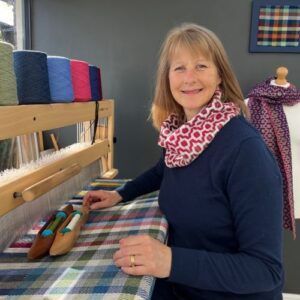
Every few months we highlight the work of a member of the Artful Collective giving you an insight into their craft, work and inspiration.
This blog focusses on handweaver and textile designer Emma Baker and will outline aspects of her work in creating luxury handwoven scarves, snoods and other accessories.
What do you create?
As a weaver and textile designer, based in Salisbury, Wiltshire, UK. I specialise in creating contemporary, one-of-a-kind accessories, including scarves, snoods and shawls. Each piece is meticulously handwoven on a traditional floor loom or table loom using luxurious yarns including fine merino lambswool, Tencel or cotton. My focus is always to create unique, high-quality items that serve as both stylish accessories and thoughtful gifts.
I weave on a large 8 shaft floor loom and smaller rigid heddle looms. Most often I weave with fine merino lambswool, but I also create a limited number of pieces using yarn which I have hand processed and spun, from local sheep and alpaca fleeces.
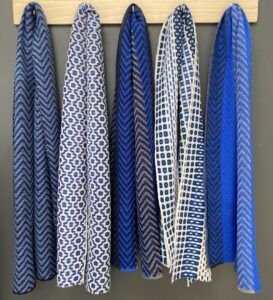
How did you get into weaving?
I have always enjoyed textile crafts and around 10 years ago my husband gave me a second hand traditional spinning wheel as a gift. I soon learnt to spin and very quickly found that my knitting couldn’t keep up with my spinning. At this time a friend told me about a weaving course that she had been on. She showed me a book she had purchased which I found fascinating. I had very little comprehension of the weaving designs in the book with their different threading and lifting plans but looking at the images I was excited to learn more. I purchased a rigid heddle loom then quickly a 4-shaft floor loom with an 8-shaft floor loom two years later. I attended a weekend course on weaving with Janet Phillips which was amazing, but I am predominantly self-taught.
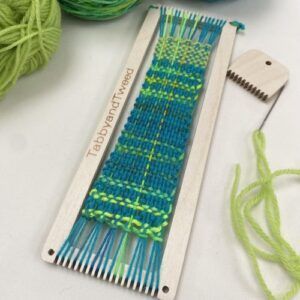
Do you work full time as a weaver?
Yes and No. Whilst I spend some time each week doing my own personal weaving, I am also half of TabbyandTweed. With my friend and fellow weaver Gill Siggers, TabbyandTweed design and make weaving loom kits and run weaving workshops. TabbyandTweed is a perfect compliment to my own weaving as I can bring my skills and experience to creating weaving kits and the running of weaving workshops. Gill and I love nothing more than helping others to learn to weave so that they can share in our passion.
Where do you get your weaving inspiration from?
Colour plays a central role in my handweaving. In weaving, the colour influences not just the overall appearance, but also how patterns, textures and the structure of the woven fabric are perceived. During weaving, the warp and weft threads cross at right angles leading to complex colour mixing with the eye optically blending the colours. I love colour and really enjoy combining different colours on the loom.
I live on the boundary of the New Forest and regular walks through the ancient woodlands and open heathlands during each season provide inspiration for my use of colours and textures on the loom.
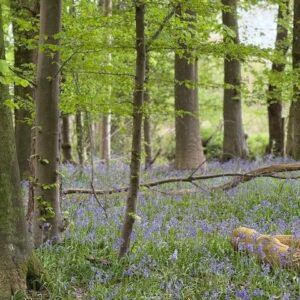
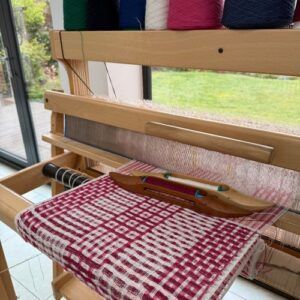
What are you currently working on?
I am currently weaving some collections of deflected doubleweave scarves and snoods. Some are new colour combinations with others being in colours which have previously been popular choices. My favourite weaving design is a deflected doubleweave which uses both plain weave and floats in different areas of the design. These floats alternately twine above and below each other, so that the two layers still form a single piece of fabric. The technique creates areas of solid colour. Upon finishing the plain and float areas of the fabric shrink differentially which often serves to soften the edges of the patterns.
How long does it take you to weave a scarf?
This is the most frequent question that I am asked at events, and it is not entirely straightforward to answer. It depends on the design and the yarn. Thicker yarns are much quicker to weave as less warp and weft threads are used in any woven area. With fine merino lambswool weaving I would usually have a warp length of around 10m which ultimately will create 3 scarves and 2 snoods. For a final woven width of around 30cm around 400 warp threads are needed. To measure and dress the floor loom with this warp takes around a day. Weaving each individual scarf then takes around 5 hours. Recently I wrote a blog article which detailed the different steps to weaving with approximate timings. You can read the blog here.
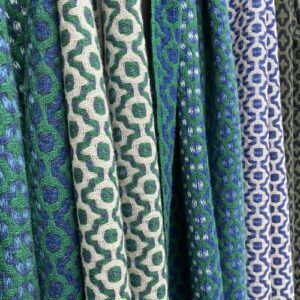
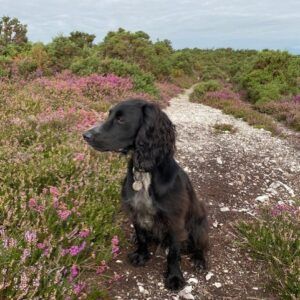
What do you do to relax?
I enjoy walking and with a rather lively cocker spaniel, a daily walk is a must. I have lots of favourite walking locations locally and around the New Forest. I also enjoy all textile crafts and am a keep spinner knitter and sewer. I sew many of my own clothes.
Do people buy your work for themselves or as gifts?
I sell my work through my website www.emmabaker.org and at various events including the Artful Christmas weekend at Sir Harold Hilliers Gardens. I find that people buy handwoven pieces for both themselves and as gifts for others. With each purchase I include a leaflet which details the handweaving process which I hope demonstrates to the recipient that they are being given a quality luxury gift which has involved care and skills its design and creation. Handwoven snoods and scarves are supplied in a beautiful gold embossed gift box.
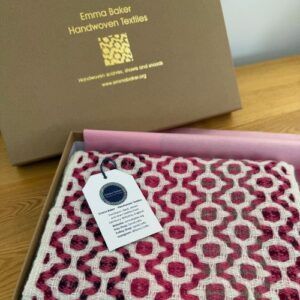
Which is most popular, a handwoven scarf or snood?
Both are popular with snoods being most often purchased in the winter months and at gifting time. Scarves are more traditional than a snood and many people like to wear a scarf to keep warm during winter as a scarf can be wrapped around the neck or draped across the shoulders. Snoods slip over the head and are simple and easy to wear, not requiring any styling which is often attractive. Snoods are great for active lifestyles and a perfect gift for a gardener, cyclist, horse rider, skier, base jumper, dog walker or commuter.
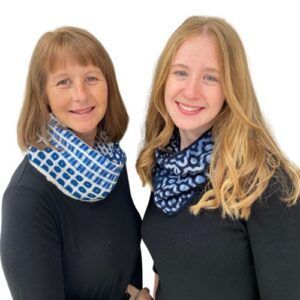
Where can you find Emma’s work?
Visit Emma’s page in the Member’s Directory – Emma Baker
Emma is also a member of Artful Collective. Click here to find out more about becoming a member.
Artful Collective Membership:
To find out more about Membership to Artful Collective and when it next opens for new applications, please visit our Membership page.
